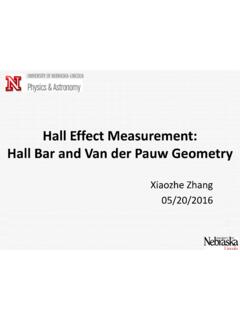Transcription of RL Circuit - New York University
1 RL CircuitEquipmentCapstone with 850 interface, 2 voltage sensors, RLC Circuit board, 2 male tomale banana leads approximately 80 cm in length1 IntroductionThe three basic linear Circuit elements are the resistor, the capacitor, and the inductor. Thislab is concerned with the characteristics of inductors and circuits consisting of a resistor andan inductor in series (RLcircuits). The primary focus will be on the response of anRLcircuit to a step voltage and a voltage square InductorsAn inductor is a 2-terminal Circuit element that stores energy in its magnetic field. Inductorsare usually constructed by winding a coil with wire. To increase the magnetic field inductorsused for low frequencies often have the inside of the coil filled with magnetic material. (Athigh frequencies such coils can be too lossy.)
2 Why?Inductors are the least perfect of thebasic Circuit elements due to the resistance of the wire they are made from. Often thisresistance is not negligible, which will become apparent when the voltages and currents inan actual Circuit are a currentIis flowing through an inductor, the voltageVLacross the inductor isproportional to the time rate of change ofI, ordIdt. We may writeVL=LdIdt,(1)where L is the inductance in henries (H). The inductance depends on the number of turns ofthe coil, the configuration of the coil, and the material that fills the coil. A henry is a largeunit of inductance. More common units are the mH and the H. A steady current througha perfect inductor (no resistance) will not produce a voltage across the inductor. The signof the voltage across an inductor depends on the sign ofdI/dtand not on the sign of thecurrent.
3 Figure 1 shows the relationship between the current and voltage for a resistor and ininductor. The arrow indicates the positive direction of the current through the two devices(resistor and inductor). That is, if the current is in the direction of the arrow, thenI >0.[Note that just because the arrows point down in the Fig. 1 doesn t mean that the current is1 Intro Experimental Physics IILab: RL CircuitFigure 1: Relationship between current and voltage in a resistor and in the downward direction. The current can also flow in the upwards direction, butin that caseI <0.]VRandVLare the potential differences across the resistor and inductor,respectively, defined such that ifV(R,L)>0, then the potential at the + end of the deviceis greater than the potential at the end. [According to this convention, ifV(R,L)<0then the potential at the bottom is greater than the potential at the top.]
4 ]According to these conventions, for the case of the resistor,V=IR. If the currentI >0(current flowing downward) the potential isgreaterat the top than at the bottom in Fig. the case of the inductor, ifdI/dt >0 then the potential is greater at the top of theinductor than at the bottom. In the inductor, one can have the situation where the currentis flowing downward (I >0), but decreasing in magnitude so thatdI/dt <0. In this caseVL=dI/dt <0, so the potential at the top issmallerthan at the potentialis always lower on the downstream end of a resistor, but for an inductor, itcan be larger or smaller, depending on therate of changeof the mentioned above, the coil of wire making up an inductor has some resistance acts like a resistorRLthat isin serieswith an ideal inductor. (An idealinductor is one with no resistance.)
5 In this situation, the voltage across the inductor isVL=LdIdt+RLI.(2) RL CircuitsA seriesRLcircuit with a voltage sourceV(t) connected across it is shown in Fig. 2. Thevoltage across the resistor and inductor are designated byVRandVL, and the current aroundthe loop byI. The signs are chosen in the conventional way;Iis positive if it is in thedirection of the arrow. Also, the positive signs of the voltages across the various componentsare indicated by the + and symbols. Kirchoff s law, which says that sum of the voltagechanges around the loop is zero, may be writtenVL+VR=V,(3)where it is assumed that the voltagesV(t),VR(t), andVL(t) can all vary with 0 (any resistance in the inductor can just be added to that of the resistor)and lettingVL=LdI/dtandVR=IR, Equation (3) becomesLdIdt+RI=V.(4)2 Intro Experimental Physics IILab: RL CircuitFigure 2: RL Circuit : The loopy arrow indicates the positive direction of the current.
6 The +and signs indicate the positive values of the potential differences across the solution to the homogeneous equation [V(t) = 0] isI(t) =I0e tL/R, whereI0is thecurrent through the Circuit at timet= 0. This solution leads immediately toVR=I0Re tL/RandVL= I0Re tL/R. The homogeneous solution decays exponentially with a time constant = interest is the response of anRLcircuit to an abrupt change in the voltageVof thesource fromV= 0 to a constant voltageV=V0. Before the change, we assume that thevoltage of the source was atV= 0 for a long time (much longer than ). The functione tL/Rdescribes the time dependence of the Circuit . To find the behavior as a function of time, itis only necessary to use physical intuition and put the appropriate two constants into thesolution. One guiding principle is that the currentI, and thereforeVRdoes not change theinstant the voltage across anRLcircuit is changed.
7 That is,VRandIare continuous. Thismeans initially, that the entire voltagechangemust appear across the :What is the basis for the argument thatIdoesn t change discontinuouslywhen the source voltage is suddenly changed fromV= 0 toV=V0?A solution to theinhomogeneousequationLdIdt+RI=V0(5)is I=V0/R. The general solution in this case is a linear combination of the homogenousand inhomogeneous solutions that satisfy the initial and final conditions. This isI=V0R(1 e tL/R).(6)This says that after the constant voltageV0is applied, the current in the Circuit will expo-nentially approachV0/Rif the inductor has no resistance, orV0/(R+RL) if the inductorhas a resistanceRL. These considerations apply whatever the previous history of theRL3 Intro Experimental Physics IILab: RL CircuitVRVoltage VR across the resistor0V0timeVLVoltage VL across the inductor00V0 Figure 3: VoltagesVRacross the resistorRandVLacross the inductorLas a function oftime after the source voltage is switched fromV= 0 toV= Consider anRLcircuit whereV= 0 and there is no current.
8 We assume thatRL=0. If att= 0 a constant voltageV0is put across the Circuit , fort 0,VLandVRare givenby,VL=V0e tL/RandVR=V0(1 e tL/R).(7)This behavior is illustrated in The current is not plotted, but remember that thecurrent is proportional toVR. Initially all ofV0appears acrossLbecause the current justbefore and after the application ofV0is zero. As the current exponentially builds up thevoltage across the resistor increases and the voltage across the inductor decreases. If we waitmany time constants =L/R, the voltages reach steady state, and we haveVR =V0andVL =0. If nowVis set equal to 0 (this is equivalent to shorting the Circuit )VLandVRwillbe given byVL= V e tL/RandVR=V e tL/R.(8)The response of anRLcircuit to an alternating pair of constant voltages, first atV0, and then0, can be observed by applying a square wave to the Circuit , alternating betweenV=V0andV= 0.
9 Figure 3 shows half the period of such an oscillation for the case where the periodTis much larger than the time constant = :How would Fig. 3 be modified if the inductor had some resistance?QUESTION:IfT L/R, what is the response of anRLcircuit to a symmetric squarewave that oscillates between +Vand V(assumeRL= 0)?If a high frequency square wave, such thatT L/R, is applied to anRLcircuit, the4 Intro Experimental Physics IILab: RL Circuitchanges in current andVRare minimal. There is not enough time for the current through theinductor to change much before the voltage is reversed. If the square wave is not symmetricwith respect to ground the averageVRwill be the average voltage of the square wave,assumingRL= 0. Fig. 6 shows the voltages for a square wave that oscillates betweenthe constant voltageVand 0 (ground).
10 The exponential dependences ofVLandVRareapproximated as straight lines and it has been assumed thatRL= 0 andT MeasuringRLIn this section the DC value ofRLwill be measured. Run the Capstone software. Go to the hardware setup window. Click on the output of the 850 interface and selectOutput Voltage - Current Senor. In the tools column, selectSignal Generatoricon and click on the 850 output 1. In waveform, pick DC, program it for 2 volts DC, and click onAuto. Next, setup a digits display and in select measurements pickOutput Current. Program the digits display for at least 2 decimal places. Connect the output of the 850 interface directly across the coil (see Fig. 4) Click Record and then your data calculateRL, the resistance of the coil. Click theFILE menu button andthenNew Experiment. Remove the wires from the your experiments compare the value ofRLto the values of the resistances usedin Experimental Physics IILab: RL CircuitInductorInductorCoreResistorsFigu re 4: Picture of the Circuit Setting up the RL Circuit and using CapstoneIn this section, the response of an RL Circuit will be examined experimentally using thesignal generator, 2 voltage sensors, and the oscilloscope display.






